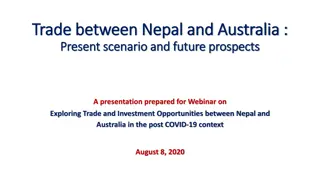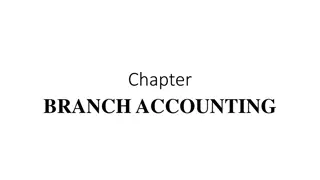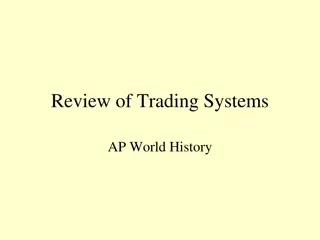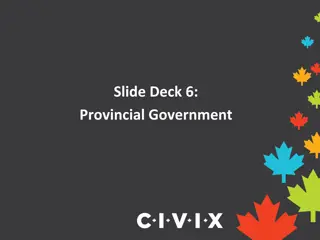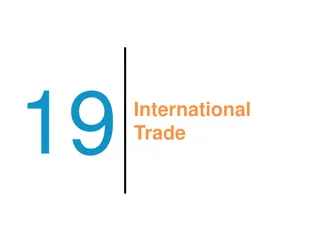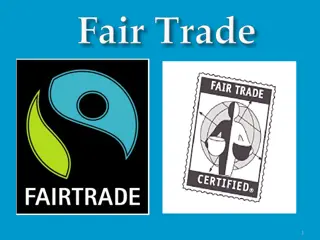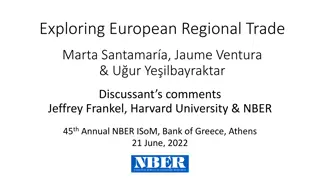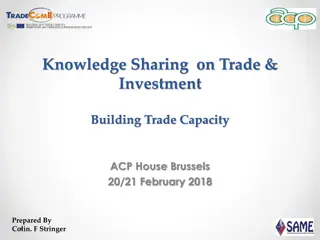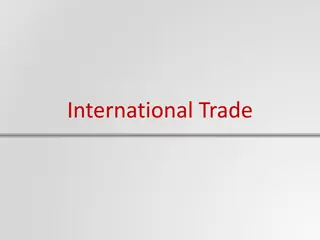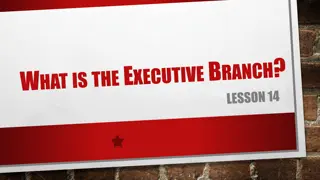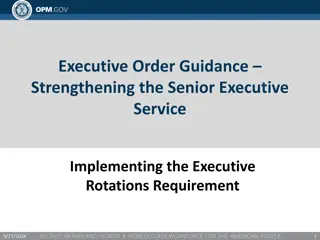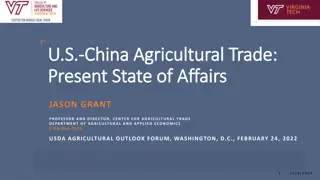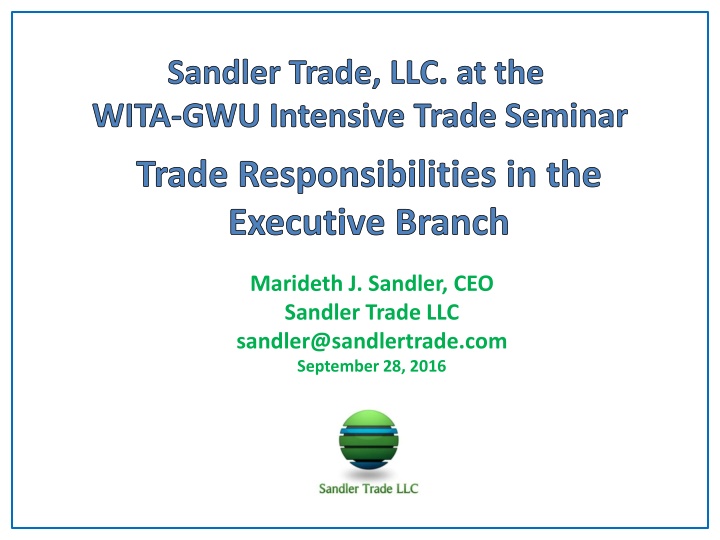
Understanding Trade Responsibilities in Executive Branch
Delve into the intricate world of international trade, examining the role of the Executive Branch in formulating and executing trade policies. Explore the statutory foundations, trade-related agencies, USTR priorities, and the power vested in the President. Unravel the alphabet soup of trade acronyms and understand the dynamics between Congress, the President, and USTR in shaping trade agreements. Gain insights into the vast landscape of trade responsibilities and the mechanisms through which they are carried out.
Download Presentation

Please find below an Image/Link to download the presentation.
The content on the website is provided AS IS for your information and personal use only. It may not be sold, licensed, or shared on other websites without obtaining consent from the author. If you encounter any issues during the download, it is possible that the publisher has removed the file from their server.
You are allowed to download the files provided on this website for personal or commercial use, subject to the condition that they are used lawfully. All files are the property of their respective owners.
The content on the website is provided AS IS for your information and personal use only. It may not be sold, licensed, or shared on other websites without obtaining consent from the author.
E N D
Presentation Transcript
Sandler Trade, LLC. at the WITA-GWU Intensive Trade Seminar Trade Responsibilities in the Executive Branch Marideth J. Sandler, CEO Sandler Trade LLC sandler@sandlertrade.com September 28, 2016
Sandler Trade, LLC. Goal: make international trade really happen from emerging markets How: strategic advisory services to expand exports into U.S. market to clients in 43 countries EOP/USTR: in the Office of the President under President Obama and President Bush Specifics: preference programs (GSP, AGOA); import regulations (CBP, FDA, FSMA); advocacy (IPR, labor, Hill); readying artisans and SMEs for the U.S. market; buyer linkage; and Ministry and business training 2
Seminar Content Alphabet soup: acronyms describe trade How the Executive Branch formulates and executes international trade policy Statutory foundation for responsibilities Trade-related agencies: what do they do? Current USTR priorities Free Trade Agreement negotiations, including private sector and Congressional roles Special: Power of the President (trade) Last words of advice Resources and links to know 3
Trade Acronyms ITEC FTA TPA TAA MTB BIT GSP AGOA FSMA TIER 1,2,3 Child labor list IEEPA POTUS NSC/NEC USTR DOL DOS USDA DOC DHS/CBP USITC TPRG/TPSC ACTPN ITAC TPP TTIP TISA TF/AfT/TCB TIFA IPR Special 301 WL/PWL AD/CVD WITA HTSUS FRN 5
Executive Branch President: Vice: Term: Limit: Elected by: Barack Obama Joseph Biden 4 Years 2 years Electoral College Members: 15 (Secretary or other head of each department) Nominated by: President Executive Office of the President: NSC, USTR, OMB, NEC, etc. Executive Office of the President: NSC, USTR, OMB, NEC, etc. 6
The Congress, President and USTR In 1934, U.S. Congress delegated to President (POTUS) authority to lower or raise tariffs as part of agreements with nations (FTAs) International Economic Emergency Powers Act of 1977 (IEEPA) gives President authority to deal with any unusual and extraordinary threat, which has its source in whole or substantial part outside the United States, to the national security, foreign policy, or economy of the United States, if the President declares a national emergency with respect to such threat President delegated to Office of the U.S. Trade Representative (USTR) the development, coordination and negotiation of U.S. international trade, commodity, and investment policies, negotiations, enforcement. USTR is in the Executive Office of the President (EOP) National Security Council (NSC) helps POTUS oversee trade policy 7
USTR = The USTR is an Ambassador and Cabinet member who serves as President s principal trade advisor, negotiator, spokesperson, and representative to WTO. Through an interagency structure (TPRG & TPSC), USTR coordinates trade policy within the Administration* USTR frames issues for POTUS decisions through consultations with Congress and standing Congressional Committees (SFC & HWM) USTR consults with 28 appointed private-sector industry & special-interest advisory groups: ACTPN, APAC, 16 ITACs, IGPAC, LAC, TEPAC, TACA: 700 people USTR s newer role: compliance and enforcement 8
Department of Commerce Mission: make U.S. businesses more innovative at home and more competitive internationally Multiple bureaus & functions to, e.g., promote U.S. exports, monitor weather, manage fish, assist small businesses, collect data, take the census, etc. Key trade-related functions: Antidumping and countervailing duty investigations Sectoral and functional support for USTR trade negotiations Trade compliance monitoring (along with USTR) Management of industry trade advisory committees Export promotion and trade missions NEI2 9
Other Agencies with Trade Responsibilities Department of State (DOS) Department of Labor (DOL) Department of Agriculture (USDA) Department of Treasury (Treas) Ex-Officio: U.S. International Trade Commission (USITC or ITC): an independent agency Administers U.S. trade laws within its mandate Dataweb with U.S. export and import data U.S. Harmonized Tariff Schedule (HTSUS) Completes independent trade studies on FTAs, GSP changes, U.S. competitiveness Staff are industry experts 10
(Opaque) Interagency Review Process: Led by USTR 19 agencies provide advice to USTR in developing and coordinating implementation of U.S. trade policy; operates by reaching consensus on issues/decisions: 90 Subcommittees (e.g., Special 301, GSP) recommend to: Trade Policy Staff Committee (AUSTR/DAS): if consensus on the decision - is final determination; if not goes to Trade Policy Review Group (Deputy USTR/Deputy or Assistant Secretary): if consensus, is final decision; if not, goes to Principals (Cabinet): if consensus, is final decision; if not goes to the President for THE final decision 11
Presidents Trade Agenda - 2016 1. Trans Pacific Partnership 2. Shaping Tomorrow s Global Economy: TTIP, FTAs, IPR, enforcement, partnerships including with the Pacific, assistance and preferences 3. Promises Delivered: jobs, growth, strengthen middle class; worker rights enforcement 12
USTR Trade Initiatives Reciprocal Free Trade Agreements (FTAs): w/20 countries Trade and Investment Framework Agreements (TIFAs): 47 TIFAs (and many other agreements) Unilateral Preferences: Generalized System of Preferences (GSP), African Growth & Opportunity Act (AGOA), Caribbean Basin Initiative (CBI), Haiti/HOPE Bilateral Investment Treaties (BITs): with 42 countries Compliance monitoring and enforcement (ITEC) WTO Agreements (TISA, Envmtal Goods, Doha)
Enforcement Mechanisms WTO cases (China, Indonesia, European Union ) FTA consultations and dispute settlement CAFTA Enforcement Mechanisms: IPR, Worker Rights, Env. Protection, Transparency, Investor Protections Columbian (FTA) Labor Action Plan Special 301 (Intellectual Property Rights (IPR) Review): Notorious Markets; Priority Watch List (PWL) 10; Watch List (WL) 27 (including Guatemala) Other Trade Barrier Reports: 1) all Foreign Trade Barriers (NTE); 2) Technical Barriers to Trade (TBT); 3) Sanitary and Phyto-Sanitary Measures (SPS). Mandatory GSP Criteria: Worker Rights, IPR, Investor Protections USDOL: Child and Forced Labor 14
FTA Negotiation Process Country requests FTA; need support by business & labor Interagency consensus to launch negotiations (assess FTA impacts, likelihood of success, etc.) President notifies Congress of intent to negotiate: 90 days During wait, USITC report; Hill & ITAC consultations begin Negotiations occur in rounds between the parties TPA-mandated consultations with House and Senate Advisory Groups from committees with jurisdiction Administration must publish updates specific to how objectives are being met in the negotiations Chief Transparency Officer (Timothy Reif) to advise USTR on transparency with Congress and public 15
FTA Approval Process President notifies Congress: intent to sign (90 days) Environmental reviews, advisory committee reports, USITC FTA economic impact report Once FTA negotiations end, attorneys do legal text scrub, Presidential announcement, and signing During course of FTA negotiation and especially after signing, Embassies, private sector associations, NGOs lobby Congress Getting FTAs through Congress: little to do with agreement substance and everything to do with U.S. politics Fast track or TPA: up/down vote approval authority, must occur within 90 days of submission 16
President Obamas Actions=Legacy Since being in office, President Obama has: Pushed through approval of three FTAs (Panama, Colombia, Korea) Re-launched Trans Pacific Partnership (TPP) and added partners Malaysia, Mexico, Canada, Japan approval? Launched the Trans Atlantic Trade and Investment Partnership Agreement (TTIP) between the U.S. and EU Launched Trade in Services Agreement (TISA) talks GSP, AGOA, Haiti preferences renewed (some for 10 yrs) Trade Promotion Authority passed Emphasis on enforcement and access for U.S. business WTO Trade Facilitation Agreement WTO Environmental Goods Agreement 17
Presidents Trade Agenda Stretches Available USTR Resources Trans Pacific Partnership Agreement (TPP) Transatlantic Trade and Investment Partnership (TTIP) Trade in Services Agreement (TISA) Implementing Bali Trade Facilitation Agreement (TF) Implementing Information Technology Agreement (ITA) Launching Environmental Goods Agreement (EGA) Participating in Strategic and Economic Dialogue (S&ED) and Joint Commission on Commerce and Trade (JCCT) with China Inform U.S. public that FTAs strengthen U.S. businesses & jobs through expanding exports (for TPP passage) 18
Key 2016 Trade Reports: USTR & USITC Digital 2 Dozen: Promotes TPP 2016 Trade Policy Agenda and 2015 Annual Report 2016 National Trade Estimate Report: U.S. exporters problems with their target markets The Colombian Labor Action Plan: A Five Year Update: labor enforcement 2016 Special 301 Report: IPR enforcement (by country) U.S. Trade Preference Programs: Reducing Poverty and Hunger in Developing Nations Through Economic Growth: Congressionally mandated Impacts of TPP (USITC) Nepal Preferences (USITC) GSP-specific, HOPE, AGOA, and Beyond AGOA 19
U.S. Trade Policy and Doing Business Tips How are you? really means What do you know? What can you tell me? What s the latest? Ask questions, even if you know the answer; you ll find out more than the answer you sought Keep your promises Meet the published deadlines U.S. trade folk often are not relationship people Keep current: e-newsletters (agencies and companies), Facebook, LinkedIn, Twitter, blogs Know which agency or person really is in charge or makes the decision (despite others claims) What you see is not always what it is, so . Keep asking questions and solicit opinions 20
Web Resources Glossary of Acronyms: http://www.ustr.gov/about- us/trade-toolbox/glossary-trade-terms U.S. Trade Representative s e-newsletter World Trade Online; Washington Trade Daily; Politico Pro (trade) Who is importing from your country: Panjiva, etc. U.S. International Trade Commission: www.usitc.gov Congressional Research Service: https://opencrs.com (also: J.F. Hornbeck paper on Congress & Trade, April 2011) Guide to U.S. Government: http://bensguide.gpo.gov/ Other: sandlertrade.com, wita.org 21
Where to Look For Trade policy ustr.gov; trade.gov Import regulations cbp.gov Import data: http://dataweb.usitc.gov/scripts/tariff_current.asp Tariff schedules, trade studies - USITC.gov; census.gov; CROSS rulings Legislation -- thomas.loc.gov Submitting comments -- regs.gov Federal notices -- federalregister.gov Can t attend a hearing but want to listen - hearings are webcast go to Committee websites 22

